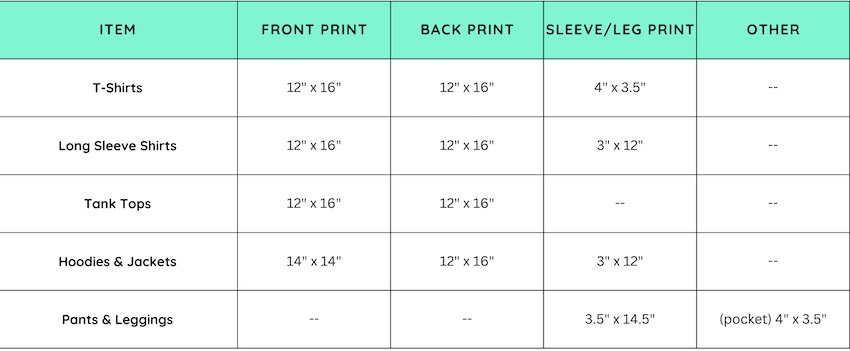Have you ever received merch that looks entirely different in-person than what it did online when you purchased it? No one wants to have a customer have that situation. This guide will help you ensure that what you have put on your storefront is what appears in the customer's hands.
There are two different printing processes that you can use for your merch, direct-to-garment (DTG) or sublimation. DTG is for wearables that are not listed as “All Over” patterns. This guide will follow the best practices for creating these types of items. If you’re looking for information about the other methods that we offer, please check out our Embroidery and All-Over guides!
What Is Direct to Garment (DTG)?
DTG is a method where the printer soaks the ink into the garment. Our fulfillment partners use eco-friendly, water-based ink. Because the ink is absorbed into the garment, it makes the print feel much softer than traditional screen-printed shirts, but it is just as durable.
How to Design for the Best DTG Merch
Print File Sizing
A print file size is the actual size that will be printed on the item. These are the maximum print file sizes that would be printed on an item but can be slightly different depending on the size of the item and the item itself.

You may notice that when you upload an image, you’re unable to resize it to the full printable area. This is because upscaling past the image's native size is restricted to preserve the quality of the image.
Dots Per Inch (DPI)
We see everything in pixels per inch for digital images, while it is dots per inch when printing. Having the correct DPI will create crisper images. However, creating files with extremely high DPIs can cause them to take up too much hard drive/disk space or be too large to upload to Streamlabs. Below are the size restrictions for files with DPIs.
Minimum DPI: 150
Maximum DPI: 300
File Format
When you save a digital image, you have various formats to save it in. You should always save/export the file as a PNG. PNGs support transparent backgrounds and keep the image's integrity when saved.
Color Space
Color matching is incredibly important. Different printers will only be able to identify certain colors. This means if you design outside the color range, it will try to guess the closest color, which can cause lackluster merch.
Designing: CMYK.
Saving: Convert to sRBG. (If you want to be super specific, sRGB IEC61966-2.1)
Transparency
We highly recommend using images with transparent backgrounds (generally a PNG file). Let's say you have an image with a black background, and you're printing it on a black item. To print the black onto the black, the printer would first need to print a white under-base, which will change the density of the black ink. This means that the printed black and the black of the garment will differ, causing the print to appear gray.
We do not recommend images with transparency within them. What does this mean? Well, basically, if you can "see through" the image it won't print well.


This is because "transparent ink" doesn't exist, meaning the printer will guess the color. This can cause a lot of headaches for the final product. If you want a faded/feathered effect, you could try one of these two options:
Option 1: Create a solid element if the element has a background. Then add a layer mask and use a soft brush to feather the edges of the element. However, if the background matches the color of the garment, don't use it on that color garment!
Option 2: You can try to use a halftone effect. This means making patterns of dots that create the illusion of a fade.
Material & Surface
Where you print your logo on garments and the type of material you print it on can drastically change the outcome of your merch. Some rules of thumb are:
- Flat surfaces are the easiest to print on
- Thinner materials will create more vibrant images (thicker materials will be slightly more faded)
- The looser the weave, the more faded the item may look. We recommend 100% cotton for a vibrant look, while poly blends/tri-blends, which have a loose weave, are good for a vintage look.
- Prints on ribbed garments are only on top of the ribs. When an item is worn, it may stretch to reveal smaller gaps.